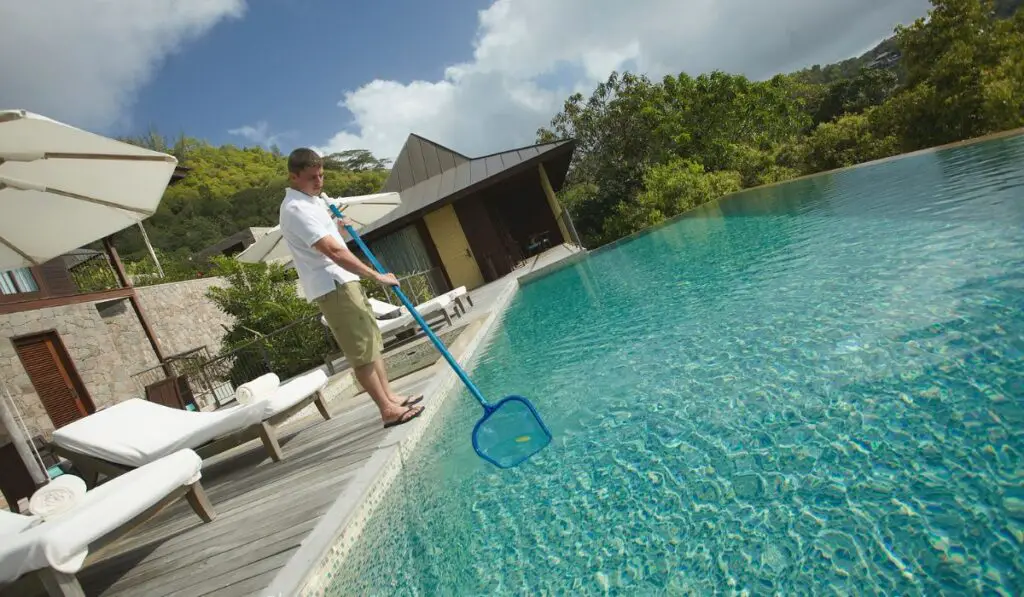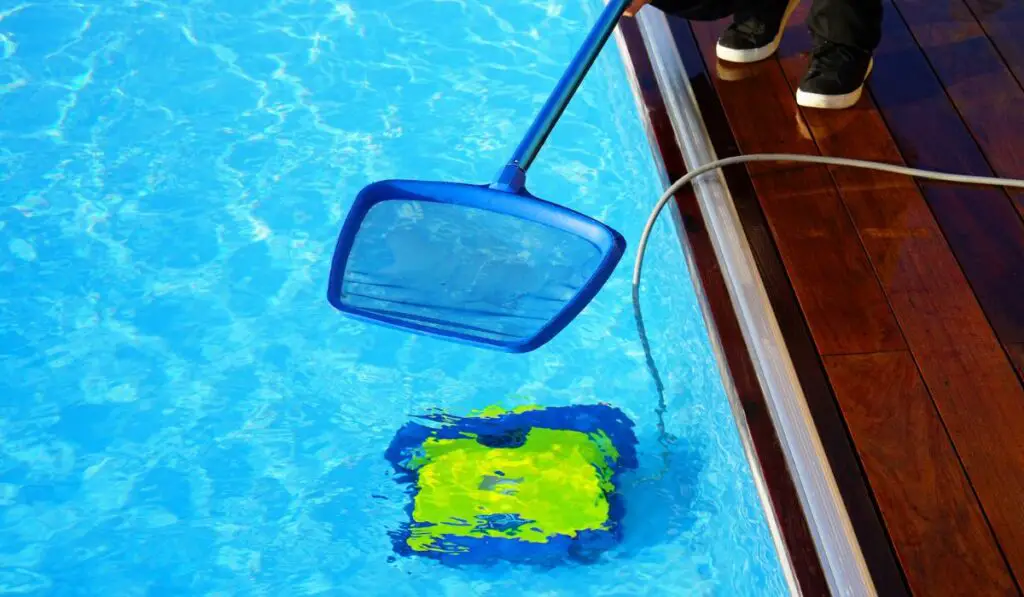If you have a pool, chances are you’ll have to deal with poop in the pool at some point. Whether it’s your child, a neighbor’s kid, or even your four-legged friend, somebody is bound to make a mess sooner or later. So, what should you do to deal with poop in the pool?
If you find poop in your pool, get everyone out and remove any visible debris with a net, then start disinfecting the pool by raising the chlorine levels. For solid-formed poop, raise it to 2 ppm and maintain it for 30 minutes. For diarrhea, raise the level to 20 ppm and maintain it for 28 hours.
People often underestimate the harm of leaving poop in a pool. Fecal matter contains germs that can cause diarrhea, vomiting, and other illnesses. So it’s important to take the necessary steps to remove and disinfect the area. Let’s find out how to clean up poop in a pool and keep everyone safe and healthy.
What Should You Do if Someone Poops in the Pool?

As soon as you suspect someone has pooped in your pool, get everyone out of the water. Feces contain germs that pose a serious health risk, so you don’t want anyone swimming in contaminated water.
Once everyone is out of the pool, it’s time to assess the situation. Solid-formed poop is dealt with differently than diarrhea. If it’s the latter, you’ll need to take extra precautions.
Start cleaning by removing as much feces from the water as possible, using a net or a bucket. Never use your pool vacuum because it’ll break the contaminants and spread them around the pool. Also, make sure you protect yourself by wearing gloves and a mask.
After you’ve removed the visible feces, it’s time to disinfect the pool water. You’ll need to use chlorine-based disinfectant, even if you normally don’t use chlorine in your pool. We get into the detailed process later on.
Can You Get Sick From Poop in a Pool?
Yes, you can. Feces contain all sorts of germs, including bacteria, viruses, and parasites, that can cause various diseases, including:
- Cholera
- Diarrhea
- E. coli infection
- Giardiasis
- Hepatitis A
- Shigellosis
- Other gastrointestinal illnesses
These diseases can be transmitted by swallowing contaminated water, or in severe cases, you can even get sick just by breathing in the fumes from a pool contaminated with feces.
One particular parasite, cryptosporidium, is highly resistant to chlorine and can survive in properly chlorinated pool water for days. Crypto is a leading cause of waterborne illnesses in the United States and is the main reason pools must have a certain level of chlorine at all times.
How Should You Properly Clean Your Pool After an Accident?
As we mentioned before, you need to deal with diarrhea incidents differently than solid-formed poop. Here is a full guide on properly cleaning your pool after an accident, depending on the type of feces you’re dealing with.
Solid-Formed Feces
- Close the pool and make sure nobody is swimming.
- Use a net or bucket to remove floating feces from the pool and dispose of it properly.
- Clean the equipment you used and then submerge it in the pool water, so it also disinfects as you clean the pool.
- Raise the chlorine level to 2 ppm and leave it for at least 30 minutes.
- If you have temperature control, make sure the water is at least 77 degrees Fahrenheit (25 degrees Celsius) for the chlorine to work properly.
- Keep the filters running during this time and backwash after 30 minutes have passed.
- Use a pool test kit (on Amazon) to check the chlorine and pH levels and adjust as needed for normal operation.
- You can let people swim again once the chlorine level has returned to normal.
Diarrheal Incident
The first three steps are the same as above; you need to close the pool, remove the feces, and disinfect your equipment. Then, proceed as follows:
- Raise the chlorine level to 10 ppm for 24 hours or 20 ppm for 13 hours at least.
- If you have a chlorine stabilizer like cyanuric acid (on Amazon) in your pool, you may need to keep the levels for a longer time. For stabilizers under 15 ppm, keep elevated chlorine for 28 hours. For stabilizers over 15 ppm, do a partial drain, dilute the pool water, and then raise the chlorine to 20 ppm for 28 hours.
- If you don’t have a stabilizer, keep the pH levels around 7.4 – 7.6, so that the chlorine is effective.
- After 24 hours, you can lower the chlorine levels and adjust the pH to normal operation.
Remember that diarrheal contamination is a serious matter. So you must follow the disinfection practice very carefully to avoid any health hazards.
If any of the steps is mismanaged, you may need to close the pool for an extended period and notify the health department.
Tips for Preventing Poop in Your Pool

The best way to deal with poop in your pool is to prevent it from happening in the first place. Here are some tips you can follow:
- Encourage swimmers to take a pre-swim bathroom break. This will help reduce the chances of accidents happening in the first place.
- Have a designated restroom area near the pool with toilet paper, soap, and towels for people to use before getting in the water.
- Make sure the pool area is clean and well-maintained. People are less likely to make a mess in a clean and well-kept pool area.
